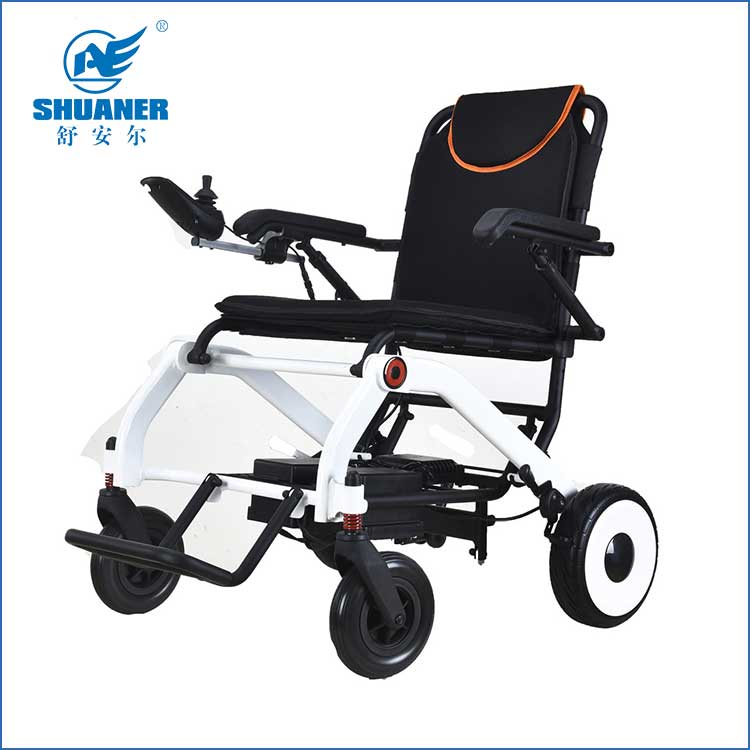- English
- Español
- Português
- русский
- Français
- 日本語
- Deutsch
- tiếng Việt
- Italiano
- Nederlands
- ภาษาไทย
- Polski
- 한국어
- Svenska
- magyar
- Malay
- বাংলা ভাষার
- Dansk
- Suomi
- हिन्दी
- Pilipino
- Türkçe
- Gaeilge
- العربية
- Indonesia
- Norsk
- تمل
- český
- ελληνικά
- український
- Javanese
- فارسی
- தமிழ்
- తెలుగు
- नेपाली
- Burmese
- български
- ລາວ
- Latine
- Қазақша
- Euskal
- Azərbaycan
- Slovenský jazyk
- Македонски
- Lietuvos
- Eesti Keel
- Română
- Slovenski
- मराठी
- Srpski језик
Components and Functions of Electric Wheelchairs (2)
2022-02-25
Components and functions of electric wheelchairs (2)
Armrests: Provides upper body support.
Full Length: Provides full support for the user's forearm.
Half-length (table length): Allows the wheelchair to be brought closer to the table top.
Armrests are available in fixed, detachable and raised, moving armrests for easy transfer.
The height of the armrest is determined according to your own situation. People with poor trunk balance can choose a slightly higher armrest.
Seat cushion: A suitable seat cushion can provide a good degree of support and body position, and prevent pressure ulcers through effective pressure buffering and pressure dispersion. The choice of seat cushion is particularly important for those who have a bad buttocks feeling.
There are many types of cushions: inflatable, gel, foam, hybrid. The choice of the general cushion needs to be selected by the occupational therapist after the pressure measurement.
Seat: The appropriate width and depth are suitable for the user and support. The width is generally about 3-5 cm away from the baffle on both sides of the hip after sitting upright. The size of the seat is moderate to facilitate passage through narrow passages. The depth should be such that it does not touch the back of the knee joint (popliteal fossa) after sitting upright. There is a 5 cm distance between the front edge of the seat and the popliteal fossa.
Wheelchair bracket: It can be divided into cross bracket and fixed bracket. Cross bracket is also called folding bracket, which is convenient for storage and transportation.
Fixed bracket: provides good stability and is easy to move forward.
Calf Straps: Provides calf support and prevents your feet from sliding backwards off the pedals.
Footrests: Provide foot and calf support, with fixed, swivel, detachable, and tiltable. The length of the footrest should be about the length of the calf (minus the thickness of the seat cushion), and the footrest should be at least 5 cm off the ground.
Wheelchair table: can be used for eating, reading, etc. Mainly used by people with poor trunk control.
Heel ring: Attached to the back of the pedal, the position of the feet, to prevent it from slipping back.
Anti-overturning device: add the rear wheel close to the ground to prevent the wheelchair from tipping over backwards. This also makes some wheelchair skills restricted and optional.
Wheelchair Bandage: The chest protection belt, used by people with poor balance ability, to prevent the wheelchair from sliding forward.
Wheelchair bag, wheelchair bag: easy to carry things
Wheelchair gloves: increase the friction of the driving wheelchair and protect the hands.
Wheel ring sweatband: increase friction, absorb sweat and protect hands.

Armrests: Provides upper body support.
Full Length: Provides full support for the user's forearm.
Half-length (table length): Allows the wheelchair to be brought closer to the table top.
Armrests are available in fixed, detachable and raised, moving armrests for easy transfer.
The height of the armrest is determined according to your own situation. People with poor trunk balance can choose a slightly higher armrest.
Seat cushion: A suitable seat cushion can provide a good degree of support and body position, and prevent pressure ulcers through effective pressure buffering and pressure dispersion. The choice of seat cushion is particularly important for those who have a bad buttocks feeling.
There are many types of cushions: inflatable, gel, foam, hybrid. The choice of the general cushion needs to be selected by the occupational therapist after the pressure measurement.
Seat: The appropriate width and depth are suitable for the user and support. The width is generally about 3-5 cm away from the baffle on both sides of the hip after sitting upright. The size of the seat is moderate to facilitate passage through narrow passages. The depth should be such that it does not touch the back of the knee joint (popliteal fossa) after sitting upright. There is a 5 cm distance between the front edge of the seat and the popliteal fossa.
Wheelchair bracket: It can be divided into cross bracket and fixed bracket. Cross bracket is also called folding bracket, which is convenient for storage and transportation.
Fixed bracket: provides good stability and is easy to move forward.
Calf Straps: Provides calf support and prevents your feet from sliding backwards off the pedals.
Footrests: Provide foot and calf support, with fixed, swivel, detachable, and tiltable. The length of the footrest should be about the length of the calf (minus the thickness of the seat cushion), and the footrest should be at least 5 cm off the ground.
Wheelchair table: can be used for eating, reading, etc. Mainly used by people with poor trunk control.
Heel ring: Attached to the back of the pedal, the position of the feet, to prevent it from slipping back.
Anti-overturning device: add the rear wheel close to the ground to prevent the wheelchair from tipping over backwards. This also makes some wheelchair skills restricted and optional.
Wheelchair Bandage: The chest protection belt, used by people with poor balance ability, to prevent the wheelchair from sliding forward.
Wheelchair bag, wheelchair bag: easy to carry things
Wheelchair gloves: increase the friction of the driving wheelchair and protect the hands.
Wheel ring sweatband: increase friction, absorb sweat and protect hands.




